Vasaka: Adhatoda vasica Uses, Side Effects, Research
Vasa – Adhatoda vasica / Malabar nut is one the powerful herbs used in treating asthma, bronchitis and excess mucous condition. This is so powerful an herb that there was an allopathic medicine syrup combination with Bromhexine and Vasa, marketed with the tag line – “With Vasaka effect”
But it was pulled out of the market by the Indian FDA, because no allopathic medicine can have an herb as an ingredient.
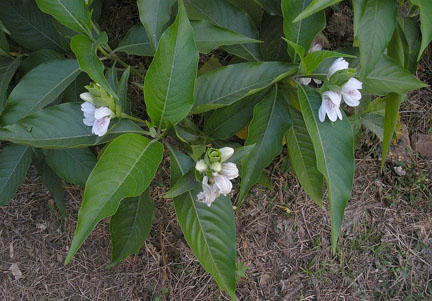
That is an altogether different story, whether the FDA was right or wrong, but it clearly indicates the efficacy and fame of this wonder herb – Vasa – Malabar Nut.
Another interesting fact is that it is a coolant herb, but it is useful in respiratory tract conditions.
Botanical Name- Adhathoda vasica Nees. (Adhatoda zeylanica Medicus), Adhatoda beddomei
Family – Acanthaceae (Vasa Kula)Adhatoda vasica Nees is an accepted botanical source of Vasa throughout India. But in Kerala Adhatoda beddomei C.B.C1 is also considered as the botanical source of Vasa.
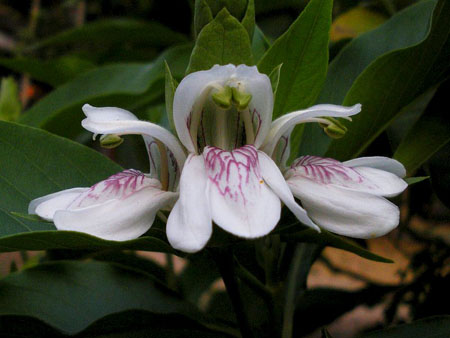
Table of Contents
Classification
Division : Spermatophyta
Subdivision : Angiospermae (Angiosperms)
Class : Dicotyledonae (Dicotyledons)
Sub class : Gamopetalae
Series : Bicarpellate
Order (Cohort) : Personales
Family : Acanthaceae
Vernacular names
Hindi Name- Adosa, Arusha, Rus, Bansa, Adusa
English Name- Malabar Nut
Telugu Name- Addasaramu, Adamkabu, Adampaka
Bengali Name- Adulsa, Bakash,Vasok
Punjabi Name-Vamsa, Bhekkar
Marathi Name- Adulsa
Malayalam name – Adolakam
Gujarati Name- Araduso, Aradusī, Adulso, Aduraspee, Bansa
Tamil Name- Eidhadad, Adathodai
Nepali name – Asuro, Kalo vasak
Persian name – Bansa
Oriya name – Basanga, Arusa, Basung
Marathi name – Adulsa, Adusa
Kannada name – Adusogae, Adu muttada soppu (the green veg that a goat never eats)
Assamese name – Titabahak, Bahak,
Konkani name – Adusoge
Sanskrit synonyms
Vasa, Vasaka, Vasika – Vasayati Acchadayati – the herb which is thick and spreads its branches to create shade area
Simhi, Simhasya – the flower resembles the mouth of lion
Vajidanta – the flowers are as white as teeth of horse
Vrisha, Vrusha – Varshati Madhu – flowers attract bees
Atarusha, Atarooshaka
Bhishagatma – mother medicine
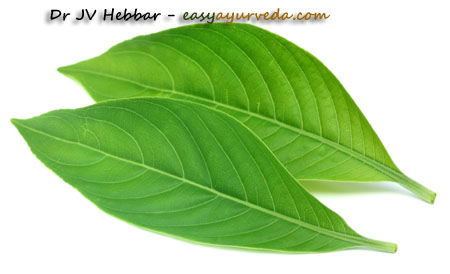
Classical categorization
Classical Categorization of Vasa
Charaka—Tikta Skandha – Bitter tasting group of herbs
Vagbhata- Durvadi Gana
B. P. Ni – Guduchyadi varga
Types:
In Brihatrayees VASA varieties is not mentioned and in Bhavaprakasha Nighantu namely he has mentioned two types
Shweta – white
Krishna/Asthiparni – black variety
Medicinal qualities
Malabar nut – Vasaka – Medicinal qualities:
Rasa (taste) – Tikta (bitter), Kashaya (astringent)
Guna (qualities) – Laghu (light), Rooksha (dryness)
Vipaka – Katu – undergoes pungent taste conversion after digestion
Veerya – Sheeta – cold potency
Karma- Balances Kapha and Pitta
Part used, dosage
Part Used- Leaf, Root, Flower, Whole plant
Vasaka Dose –
Leaf Juice – 10-20 ml;
Root decoction 40-80 ml; flower juice- 10-20 ml
Leaf dry powder – 1 – 3 grams, once or twice a day
Vasa Putapaka Swarasa – Juice extract by Putapaka method – 24 – 48 ml, once or twice a day
Vasa Ghrita – herbal ghee – 5 – 10 grams once or twice a day before food or as directed by an Ayurveda doctor.
Sanskrit verse
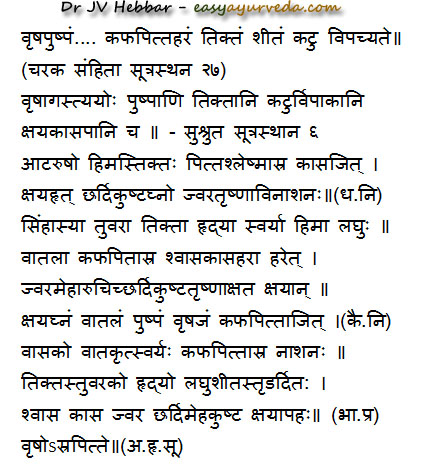
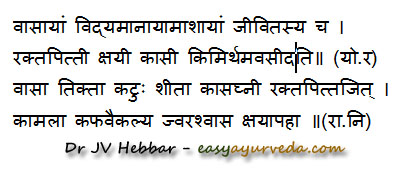
Uses
Malabar Nut – Adhatoda – uses
The flower –
Balances Kapha and Pitta.
It is bitter, coolant and pungent.
Kshaya – useful in chronic respiratory tract infections,
Kasa – useful in colds and coughs.
It is useful to relieve burning urination
The whole plant –
Asrajit – useful in bleeding disorders, detoxifies blood
Kshaya – useful in chronic respiratory tract infections,
Kasa – useful in colds and coughs.
Chardi – useful in vomiting
Kushta -useful in skin disorders
Jwara – useful in fever
Trut, Trushna – useful in excessive thirst
Hrudya – acts as cardiac tonic,
Svarya – good for throat
Shwasahara – useful in asthma, chronic bronchitis
Mehahara – Useful in urinary tract disorders, diabetes
Aruchi – useful in anorexia
Raktapitta – useful in bleeding disorders
Kaamala – useful in jaundice and liver disorders.
Of all the herbs useful in bleeding disorders, Vasa is the best.
Its leaves are made into paste and applied to relieve inflammation, pain, rheumatoid arthritis, worm infested wounds and skin disorders.
It acts as diuretic.
Side effects
People with diabetes should use this medicine with care, because it helps to reduce blood sugar levels. Hence, the dose needs to be calibrated diligently.
It is safe to use in children above 1 year of age.
It is best to avoid in pregnancy. Can be used in lactation, under medical supervision.
Interaction with medicines, supplements
Can this be used while taking Homeopathic medicine?
Yes. This product does not react with homeopathic medicine.
Can this medicine be continued while taking supplements like multivitamin tablets, Omega 3 fatty acids etc?
Yes. Generally, this product goes well with most dietary supplements. However, if you are taking more than one product per day, please consult your doctor for an opinion.
With western
medicines
Seek your
doctor’s advice if you are taking this product along with other western
(allopathic / modern) medicines. Some Ayurvedic herbs can interact with modern
medicine.
If both Ayurvedic and allopathic medicines are advised together, then it is
best to take Allopathic medicine first, wait for 30 minutes and then take the
Ayurvedic medicine.
Distribution
Found throughout India, Usually grown on beside compounds
Morphology
Habit- Perennial under shrub.
Root-Tap-root, branched.
Stem- Herbaceous above, woody below, branched, branches swollen at the nodes, solid, angular, hairy, greenish-yellow.
Leaf- Simple, opposite, lanceolate, entire acute, coriaceous with unicostate reticulate venation, small petiole.
Inflorescence- Racemose, A terminal spike.
Flower- Bracteate, zygomorphic, bilabiate, whitish with pink streaks. Sepals are five, green and valvate aestivation. Petals are five bi lipped, gamo petalous, posterior lips with two lobes.
Fruit-Capsule
Useful part- Leaves
Substitute
Adathoda beddomi in Kerala
Chemical constituents
Adhatoda vasica chemical Constituents
Vasicine (peganine), Vasicinine, B- Sitosterol, Kaempferol, 3- Sophoroside, Luteolin, Tritriacontane, Adhatodic acid, Carotene, Vasakin, Vasicinol 1= q- Hydroxyvasicinine, Vasicinone, Vit –C, vasicol. Vasicinol, Vaicinolone, Adhatodine, Adhavasinone, Anisotine, Vasicolone, Vasicolinone etc.
(Reference: Illustrated Dravyaguna Vijnana, Vol. II, by Dr JLN Shastry)
Research
Antimicrobial activity against clinical pathogens
Anti ulcer activity
Hepatoprotective activity of Vasaka
Anti oxidant and antimicrobial activity
Ayurvedic Home remedies
For Laryngitis – hoarse voice – 1 teaspoon of juice is administered along with 2 teaspoons of honey, twice a day after food for 1 week.
Use in Rasashastra
Uses in Rasashastra – metallic Ayurvedic medicines:
Vasaka is used in the process of purification of Vimala (Iron pyrite). Vimala is tied in a pack and sudation (Swedana) is given with the leaf juice extract of Vasaka for 3 hours.
Ayurveda medicines
Ayurveda medicine with Vasaka as ingredient:
Vasarishta – used in cold, cough and asthma
Mathala rasayanam – indicated in almost all the conditions in which malabar nut is indicated.
Maha Vishagarbh Tail – Used in sciatica, stiffness and tetanus
Special Ayurvedic medicines of Vasa
Charaka Samhita
Atarushadi kwatha – Raktapitta – C.Chi.4/65
Vasa ghrita Gulma, Jwara C.Chi.5/126-127
Kanakabindvarishta Kusta C.Chi.7/76-79
Mahakhadiradi ghrita Kusta C.Chi.7/152-156
Chandanadya ghrita Grahani C.Chi.15/125-128
Amrita ghrita Visha C.Chi.23/243
Vrushamuladi taila Vata vyadhi C.Chi.28/170
Triphaladi kalka Vatashonita C.Chi.29/152
Vrushakadi choorna Yonivyapat C.Chi.30/56
Mahatiktaka ghrita Kusta, Jwara C.Chi.7/144-150
Sushruta Samhita
Vasadi Kashaya Vata vyadi Su.Su.4/30
Astanga Hridaya
Vasa ghirta Raktapitta, Jwara A.H.Chi.2/40
Duralabharista Arsha A.H.Chi.8/70
Vrsadi ghirta Kasa, Jwara A.H.Chi.3/162
Chandanadi ghrita Grahani dosa A.H.Chi.10/42
Mahatiktaka ghrita Kushta A.H.Chi.19/9
Vajaraka ghrita Kushta, Jwara A.H.Chi.19/18
Patoladi ghrita Vruna, Jwara A.H.K.13/6-9
Astanga Sangraha
Vasa ghrita Raktapitta, Jwara A.S.Chi.3/63
Duralabh Arista Arsha A.S.Chi.10/20
Mahatikta ghirta Kushta A.S.Chi.21/4
Maha triphala ghrita Timira pratisweda A.S.U.16/14
Patoladi ghrita Timira pratisweda A.S.U.16/7-10
Sarangadhara Samhita
Vasakadi swarasa Raktapitta, Jwara Sh.S.Mk.1/8
Vasaputapaka Raktapitta, Jwara Sh.S.Mk.1/34
Bunimbadi kwatha Kapha jwara Sh.S.Mk.2/19
Panchakamaha kwatha Vishama jwara Sh.S.Mk.2/51
Devadaru churna Vhaturtaka jwara Sh.S.Mk.2/58
Panhatikta ghirta Vishama jwara Sh.S.Mk.9/91
Devadarvyadi rasa Prameha Sh.S.Mk.10/53
Chakradatta
Duralabhadi kwatha Jwara (Pittaja) Chakradatta.1/84
Triphala kwatha Kaphaja jwara Chakradatta.1/107
Vasa swarasa Jwara (Kaphapitta) Chakradatta.1/127
Vasadya ghrita Jwara Chakradatta.1/258
Panchatikta ghirta Kushta Chakradatta.50/99
Vasa guggulu Amlapitta Chakradatta.52/13
Eladi kwatha Ashmari Chakradatta.34/32
Pancha kasaya Vamana prakarna Chakradatta.70/10
Guduchyadipancha ghrita Jwara Chakradatta.1/260
Bhavaprakasha
Guduchyadi kwatha Jwaradikar B.P.Mk.8,1/358
Kshudradi kwatha Jwaradikara B.P.Mk.8,1/660
Danyadi hima Raktapittadikara B.P.Mk.8, 9/23
Vasavakha Rajayakshmadikara B.P.Mk.8,11/55
Pipplyadi kwatha Kasa roga B.P.Mk.8, 12/26
Patoladi kwatha Jwara B.P.Mk.8, 1/835
Sthanika Karma (Systemic Action)
External – External application of leaf paste relieves pain and edema. Paste is indicated in Arthritic pain, skin disorders etc. Its Oil is beneficial in Epilepsy, Tremor etc. Leaf juice is indicated in worm infestation
Digestive System – Absorbent, Indicated in bloody diarrhea
Circulatory System – good for heart, Constrict blood vessels, Styptic, indicated in bleeding disorders, Bleeding in hemorrhoid’s, Epistaxis, Menorrhagia etc.
Respiratory System – Pacify kapha dosha, Liquefy kapha from the respiratory passage and helps to expel it out. Indicated in Cough, Rajayakshma (Tuberculosis). Dhumapana with Vasa leaf powder mixed with Dattura Leaf powder is helpful to reduce asthma attacks.
Satmikarana – Indicated in Rajayakshma, Facilitate tissue repair. Excretory system – Flower is indicated in Dysuria, Burning micturition, Diabetes
Tapakrama – Indicated in Fever











11 comments
shirisha
in telangana were it is found not mentioned
Dr J V Hebbar MD(Ayu)Author
Vasaka capsules are found in medical stores.
Craig Revell
Great information! I am a Pitta dominant person with a recurring cough that comes especially bad as spring becomes summer. Sitopaladi and Talidasi aggravate my Pitta and I can’t wait to try this herb. Your website is a great resource and the first place I look when I am investigating new herbs. Thank you!
Sukant Sahu
how long one should take Vasaka Juice in severe cases?
Is it a steroid ? any side effect of its long use pls.advise
Abhijit ghosh
Name of Rajasthan
Dr J V Hebbar MD(Ayu)Author
Not known.
Sukant Sahu
many many thanks dr. Hebbar.i m from odisha malkangiri dist. let me know one thing ……the does of vasaka juice in severe cases for adults. pls help.
Priyanka Dasugari
Thank you sir for translating all ayurvedic medical herbal uses into english.
Anita
Sir, pls help. I am having prolonged cough for more than 1 year with heavy phlegm due to excess kapha. No breathing difficulty. Also my agni is poor and i have dimnished appetite. Is Vasa a good herb in my case too? Or would you suggest something else.
Rajani Harish Nair
Hi is there any cure for osteoarthritis in ayurveda
Arvind
Can freshly prepared vasa swarasa or kashayam be given as supportive medicine when a child is on antibiotics for pharyngitis associated with cold and cough. Will it have any interaction with the antibiotics? Is it safe to give ? If so what dose doctor. The child is 4yr